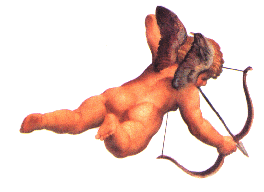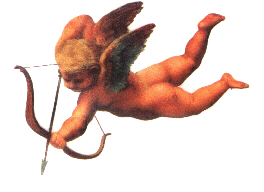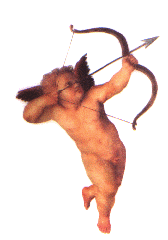|
Origin of
Valentine's Day  Valentine's Day as you and I
know it probably originated from the ancient belief that birds (particularly
lovebirds) began to mate on February
14th. The 14th was also a designated feast day (until 1969, when it was dropped from
the Roman Catholic calendar) to honor two Christian saints (at least one named
Saint Valentine) martyred by the Roman Emperor Claudius II Gothicus. There is a little bit of love stuff in this
part, though --
the reason Saint Valentine was killed (beheaded, actually) was
that he continued to marry young couples even though Claudius forbade it. Apparently Claudius thought that married soldiers
weren't as good as single soldiers. On top of all that, in
ancient Rome, February the 15th was the fertility festival (Lupercalia) in honor of the pastoral god
Lupercus. Through the
centuries it all kind of got merged together, and the modern Saint Valentine's Day is a day dedicated to
lovers, a time to exchange
sentimental greeting cards and mushy words of never-ending adoration. Valentine's Day as you and I
know it probably originated from the ancient belief that birds (particularly
lovebirds) began to mate on February
14th. The 14th was also a designated feast day (until 1969, when it was dropped from
the Roman Catholic calendar) to honor two Christian saints (at least one named
Saint Valentine) martyred by the Roman Emperor Claudius II Gothicus. There is a little bit of love stuff in this
part, though --
the reason Saint Valentine was killed (beheaded, actually) was
that he continued to marry young couples even though Claudius forbade it. Apparently Claudius thought that married soldiers
weren't as good as single soldiers. On top of all that, in
ancient Rome, February the 15th was the fertility festival (Lupercalia) in honor of the pastoral god
Lupercus. Through the
centuries it all kind of got merged together, and the modern Saint Valentine's Day is a day dedicated to
lovers, a time to exchange
sentimental greeting cards and mushy words of never-ending adoration.
Origin of Valentine's
Day(What is the truth anyway?)
 February 14 is Valentine's Day in the
US, and a few other countries. It is loosely based on the Roman lover's festival of
Lupercalia. Most people
don't know there were actually two Saint Valentines. One was a priest in
Rome, another a
Bishop in Interamna. Strangely enuff, both were beheaded. In their honor, people
everywhere have since been losing their heads on Valentine's Day. February 14 is Valentine's Day in the
US, and a few other countries. It is loosely based on the Roman lover's festival of
Lupercalia. Most people
don't know there were actually two Saint Valentines. One was a priest in
Rome, another a
Bishop in Interamna. Strangely enuff, both were beheaded. In their honor, people
everywhere have since been losing their heads on Valentine's Day.
And as if two headless clerics weren't
enuff to inspire tons of romance and passion, we throw in this lil' nude cherub named
Cupid (Eros to you Greeks) who flies about shooting people in the heart with
arrows. I
assume that's why red is the primary color of the day -- all that internal bleeding and
all. Cupid was the Roman God of Love who
stayed with his wife, the Princess Psyche, only at night. Actually, that's not a bad deal
at all if you can swing it guys.
People in England celebrated the holiday
beginning in 1446. They would write their names on slips of paper and draw from a vase for
a partner. And here we in the US thought we invented wife swapping in the 1960's.
 In the 1700's, the custom of pinning these slips of paper to
one's sleeve became popular, where it was worn for several days after. Romantics would
have you believe that this is where the expression "He wears his heart on his
sleeve" comes from, when actually, this was an early attempt to pinpoint and
follow-up on any sexually transmitted diseases. In the 1700's, the custom of pinning these slips of paper to
one's sleeve became popular, where it was worn for several days after. Romantics would
have you believe that this is where the expression "He wears his heart on his
sleeve" comes from, when actually, this was an early attempt to pinpoint and
follow-up on any sexually transmitted diseases.
During the 1800's in the US, the custom
of exchanging cards adorned with sea shells and seaweed became popular. I guess if you're
gonna drown in a sea of sentimentality, you might as well have the appropriate
accouterments.
So there ya have it y'all. May the
Headless Horseman bless... No wait -- wrong headless guy... that's Halloween... never mind |
